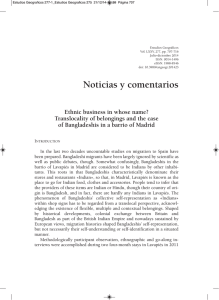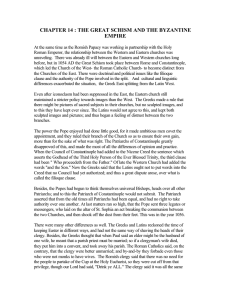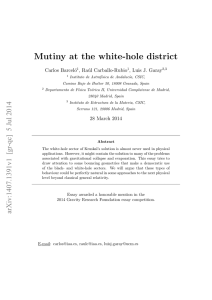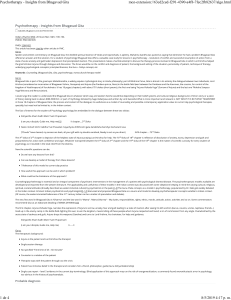Colonialismo Inglés en Asia
Anuncio
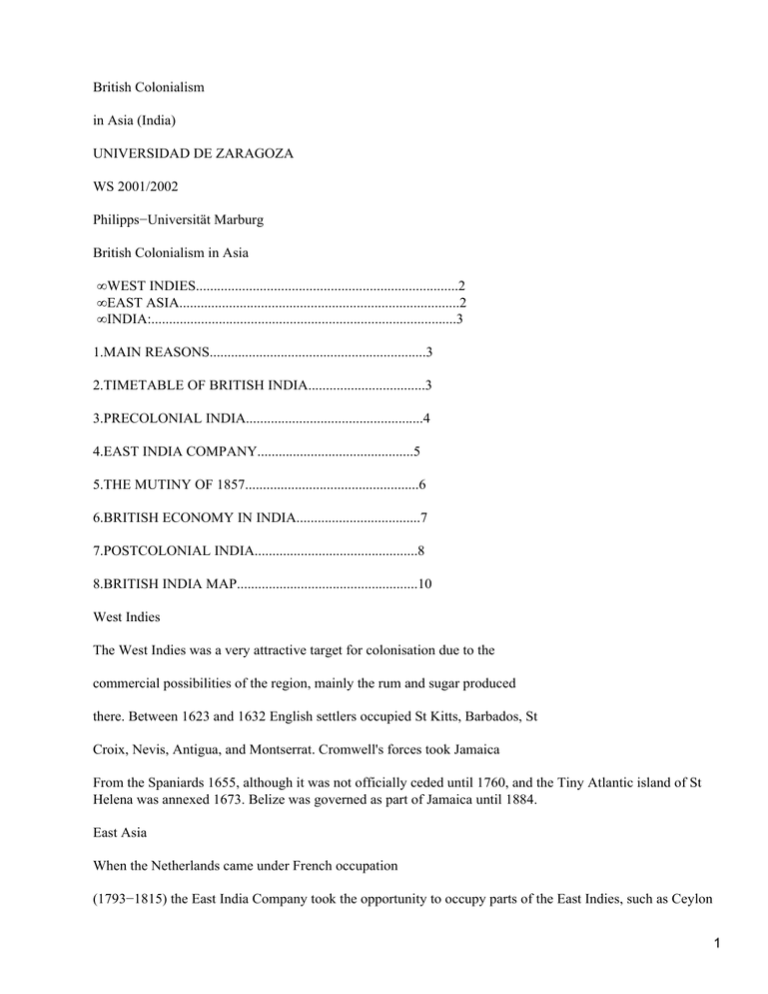
British Colonialism in Asia (India) UNIVERSIDAD DE ZARAGOZA WS 2001/2002 Philipps−Universität Marburg British Colonialism in Asia • WEST INDIES..........................................................................2 • EAST ASIA...............................................................................2 • INDIA:......................................................................................3 1.MAIN REASONS.............................................................3 2.TIMETABLE OF BRITISH INDIA.................................3 3.PRECOLONIAL INDIA..................................................4 4.EAST INDIA COMPANY............................................5 5.THE MUTINY OF 1857.................................................6 6.BRITISH ECONOMY IN INDIA...................................7 7.POSTCOLONIAL INDIA..............................................8 8.BRITISH INDIA MAP...................................................10 West Indies The West Indies was a very attractive target for colonisation due to the commercial possibilities of the region, mainly the rum and sugar produced there. Between 1623 and 1632 English settlers occupied St Kitts, Barbados, St Croix, Nevis, Antigua, and Montserrat. Cromwell's forces took Jamaica From the Spaniards 1655, although it was not officially ceded until 1760, and the Tiny Atlantic island of St Helena was annexed 1673. Belize was governed as part of Jamaica until 1884. East Asia When the Netherlands came under French occupation (1793−1815) the East India Company took the opportunity to occupy parts of the East Indies, such as Ceylon 1 (now Sri Lanka) annexed to the East India Company in 1796. When the British government took over from the company it also acquired the Straits Settlements and by 1914 all Malaya was under British control. Britain gained Hong Kong as a result of the Opium Wars 1839−42 and Kowloon was added to the colony after a second Opium War (1856−58). Burma (now Myanmar) became a province of British India 1886 after a series of Anglo−Burmese Wars from 1824. In Borneo, Sarawak was ruled as a personal possession by James Brooke, a former soldier of the East India Company, and the British North Borneo Company acquired Sabah 1888. The sultanate of Brunei, which had formerly possessed Sarawak and Sabah, itself came under British protection in the same year. Burma and Ceylon became independent 1948 and the republic of Sri Lanka dates from 1972. India • Main reasons for the conquest of India by the British were: − Decline of the Mughal rulers. −Better technology of the British army −Superior sea power, which not only enabled military strength, but allowed the British economic resilience −An esprit de corps among the British soldiers, a sense that destiny could reward the adventurous. The British view of India was that it became the Jewel in the Crown of a glorious empire. As more countries came under British rule, the concept grew that the British were destined to rule by a moral superiority. 2) TIMETABLE OF BRITISH INDIA 1600 The East India Company (EIC) is formed, 1600. 1615 The company acquires it's first territory in Bombay. 1748 Anglo−French War In India. 1757 War of Plassey. 1792 The EIC defeats the Marathas and Tippu Sultan of Mysore. 2 1857 Mutiny of the Indian Army at Barrackpore. The Rebellion becomes a War of Independence First Indian War of Independence. 1858 Bahadur Shah Zafar, The Last Mogul, is proclaimed as Emperor. The Mutiny is Crushed and the Last Mogul Emperor, is disposed. The Revolt is crushed ruthlessly. End of the EIC's rule in India. End of Mogul rule in India. British Crown takes over India, beginning of the Raj. 1869 Mahatma Gandhi born in Porbandar, Gujarat (Oct 2) 1877 Queen Victoria becomes the Empress of India. 1885 Indian National Congress is formed. 1897 Queen Victoria's Diamond Jubilee. 1914 The Great War breaks out in Europe. 1919 Jalianwala Bagh Massacre. Parliament passes the Rowlatt Acts. 1939 World War II breaks out with Germany's invasion of Poland. 3 1947 India and Pakistan become self−governing. 3) PREBRITISH INDIA British control of India was largely brought about by the fall of the Mogul Empire in the 18th Century and the subsequent division of India. The Moguls were Muslims who ruled over a Hindu majority. The founder of the Mogul Empire was Babar (1482−1530), a Turkish−Mongol prince from Afghanistan and invaded India in 1526. His grandson Jelaleddin Mahmomet Akbar (1542−1605) was the greatest of the Mogul emperors and under his 49 years reign, conquered all of Northern India and Afghanistan. After his death, the empire began to decline and this decline continued with the rule of Aurangzeb and Bahadur Shah I from 1707. From then till 1761 there was a rise of the provinces against Delhi. They became increasing independent from the central authority both economically and politically. This gave rise to the princely states of British India. However, the princes were thus never strong enough to dominate any sizeable territories and the Mogul Empire, shrank thought in 1858. India became from that moment the heart of the British Empire but it was initially controlled not by the British government but by the East India Company India. 4) EAST INDIA COMPANY Between (1600−1708), a Company Of Merchants Of London Trading Into The East Indies, or (1708−1873) United Company Of Merchants Of England Trading To The East Indies, English company formed for the exploitation of trade with East and Southeast Asia and India. In that moment India had 5 millions Km2 and a population of nearly 300 millions people. Starting as a monopolistic trading body, the company became involved in politics and acted as an agent of British imperialism in India from the early 18th century to the mid−19th century. In addition, the activities of the company in China in the 19th century served as a catalyst for the expansion of British influence there. In fact, the East India Company was the most powerful private company in history, controlling India partly by direct rule and partly by a system of alliances with Indian princes, maintained by the Company's powerful army. The company was formed to share in the East Indian spice trade. This trade had been a monopoly of Spain and Portugal until the defeat of the Spanish Armada (1588) by England and gave the English the chance to break the monopoly. The company met with opposition from the Dutch in the Dutch East Indies (now Indonesia) and the Portuguese. The Dutch virtually excluded company members from the East Indies after the Amboina Massacre in 1623 (an incident in which English, Japanese, and Portuguese traders were executed by Dutch authorities), but the company's defeat of the Portuguese in India (1612) won them trading concessions from the Mughal Empire. The company settled down to a trade in cotton and silk piece goods, indigo, and saltpetre, with spices from South India. It extended its activities to the Persian Gulf, Southeast Asia, and East Asia. Nevertheless, after the mid−18th century the cotton−goods trade declined, while tea became an important import from China. At the beginning in the early 19th century, the company financed the tea trade with illegal opium exports to China. Chinese opposition to this trade precipitated the first Opium War (1839−42), which resulted in a 4 Chinese defeat and the expansion of British trading privileges; a second conflict, often called the "Arrow" War (1856−60), brought increased trading rights for Europeans. The original company faced opposition to its monopoly, which led to the establishment of a rival company and the fusion (1708) of the two as the United Company of Merchants of England trading to the East Indies. When the company acquired control of Bengal in 1757, Indian policy was until 1773 influenced by shareholders' meetings, where votes could be bought by the purchase of shares. This led to government intervention which stablished a government control of political policy through the Parliament. Thereafter, the company gradually lost both commercial and political control. Its commercial monopoly was broken in 1813, and from 1834 it was merely a managing agency for the British government of India. It was deprived of this after the Indian Mutiny (1857), and it ceased to exist as a legal entity in 1873. 5) MUTINY OF 1857 "We could subdue the mutiny of 1857, formidable as it was, because it spread through only a part of the army, because people did not actively sympathise with it, and because it was possible to find native Indian races who would fight on our side. But the moment a mutiny is but threatened, which shall be no mere mutiny, but the expression of a universal feeling of nationality, at that moment all hope is at an end, as all desire should be at an end, of our preserving our Empire." −− Sir John Seeley (quoted by Tarling) The 1857 rebellion, which began with the mutiny of Indian troops stationed near Delhi, had several chief results: 1.a year−long insurrection that changed attitudes −− both British and Indian −− towards British rule of India 2.dissolution of the British British East India Company 3.beginning of the British Raj, the period during which the U. K. directly ruled the Indian subcontinent 4.the end of the Mughal Empire after the British exiled Emperor Bahadur Shah to Burma The revolt, mutiny, or rebellion, which some have seen as the first Indian war of independence, began on May 10, 1857. Indian soldiers of the British Indian Army, drawn mostly from Muslim units from Bengal, mutinied at the Meerut cantonment near Delhi, starting a year−long insurrection against the British. The mutineers then marched to Delhi and offered their services to the Mughal emperor, whose predecessors had suffered an ignoble defeat 100 years earlier. In a wide sense, the insurrection was a reaction by the indigenous population to rapid changes in the social order engineered by the British over the preceding century and an abortive attempt by the Muslims to resurrect a dying political order. After the mutineers (or patriots) finally surrendered on June 20, 1858, theBritish ended the East India 5 Company, and Queen Victoria was proclaimed empress of India 1 Jan 1877. With the coming of the Raj, a British governor general (or "Viceroy" as he was known when representing the British crown) ruled India, and he in turn reported to the secretary of state for India, a member of Prime Minister's cabinet. The mutiny, which ended by destroying the Mughal Empire, had major effects on the U. K. as well, forcing the British government to assume direct control over the Indian subcontinent. At home, many English, who felt betrayed by peoples they thought they had befriended, experienced the revolt as a trauma. (Newspapers of the period emphasised atrocities, particularly toward women and children, committed by the rebels, and these became the subjects of very well known contemporary paintings). BRITISH ECONOMY ECONOMIC LOGIC OF COLONIALISM Mercantile Phase: Initial interest in India only for trade, large profits to be made from India trade. Problem is trade deficit. Military victories and rights to collect revenue from India solved that problem. Initially, brutal collection policy creates a famine in which 1/3 of the population of Bengal dies. Then, through the Permanent Settlement of 1793 actually create a class of landowners in Bengal. Phase of Industrial Capitalism: With the beginning of the Industrial Revolution in England (late 1700s, but more evidently by 1810−1820), India becomes important now as a captive market for British manufactures. Peasants important because they produce raw materials for British factories, but also as possible consumers of British goods. The Ryotwari and Mahalwari systems of revenue collection avoided some mistakes of the Permanent Settlement, but reinforced private property in land. Because peasant couldn't now be thrown off the land for non−payment, they were encouraged to produce for the market rather than for personal or family consumption. This Commercialisation of Agriculture made them dependent on vagaries of the market at terms very unfavourable to them. POSTCOLONIAL INDIA Britain's hold on India had gradually loosened. India achieved qualified self−government in 1935 and independence in 1947. It was the time in England lost all its colonies except for Hong−Kong: Ireland, which had at last won dominion status in 1921 after a brutal guerrilla war, achieved independence in 1949, although the northern province of Ulster remained (as it is today) a part of Great Britain. The process of decolonisation in Africa and Asia accelerated during the late 1950s. On 15 August 1947, India acquired its independence from Britain. The newly−appointed Constituent Assembly was given the task of drafting a constitution for India, and the greater part of this onerous responsibility fell upon the shoulders of B. R. Ambedkar, who was elected chairman of the drafting committee. There was much irony in this: as the leader of the "Untouchables", as they were then called, Ambedkar had been the most unremitting foe of Gandhi, the "Father of the Nation". Ambedkar, who was Law Minister in the Government of India, and his colleagues made a careful study of the constitutions of various countries, besides considering the common law traditions of Britain and the decisions of the Supreme Court of the United States. The Constitution of India guarantees equal rights to all citizens, and prohibits discrimination on the basis of race, ethnicity, gender, caste, and religion; it also allows universal franchise, thereby making the Indian electorate the largest in the world. The Fourth Part of the Constitution contains what are called "directive principles of state policy", which require the government to set goals for the welfare of the people, such as a minimum wage, jobs for people from disadvantaged backgrounds, and subsidised medical care. The India 6 Constitution is one of the largest in the world, and comprehensive and sweeping in its scope. The Indian state, however, has been act in its commitment to enforce the "directive principles", and constitutional rights have been abrogated much too often. During the internal emergency of 1975−77, proclaimed by Prime Minister Indira Gandhi, the Constitution was sadly rendered ineffective. In recent years, the Supreme Court of India, as well as the higher courts, have shown much daring in so interpreting the Constitution as to advantage the oppressed, the poor, and the victims of state and police brutality. Indeed, the Supreme Court has become renowned for its judicial activism and what is termed Public Interest Litigation or Social Action Litigation. The Constitution remains a vital and living document, and the political awareness of recent years suggests that it will continue to be a source of inspiration for those who strive valiantly to make Indian society more egalitarian and just. CONCLUSION Today, any affinities which remain between former portions of the Empire are primarily linguistic or cultural rather than political. After 155 years of foreign occupation, the last imperialist bastion in Asia is being scratched off the map. On July 1 the British Crown Colony of Hong Kong returns to the rightful sovereignty of China. 2 9 7
